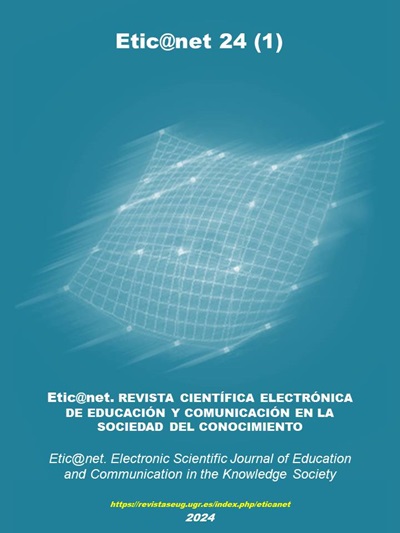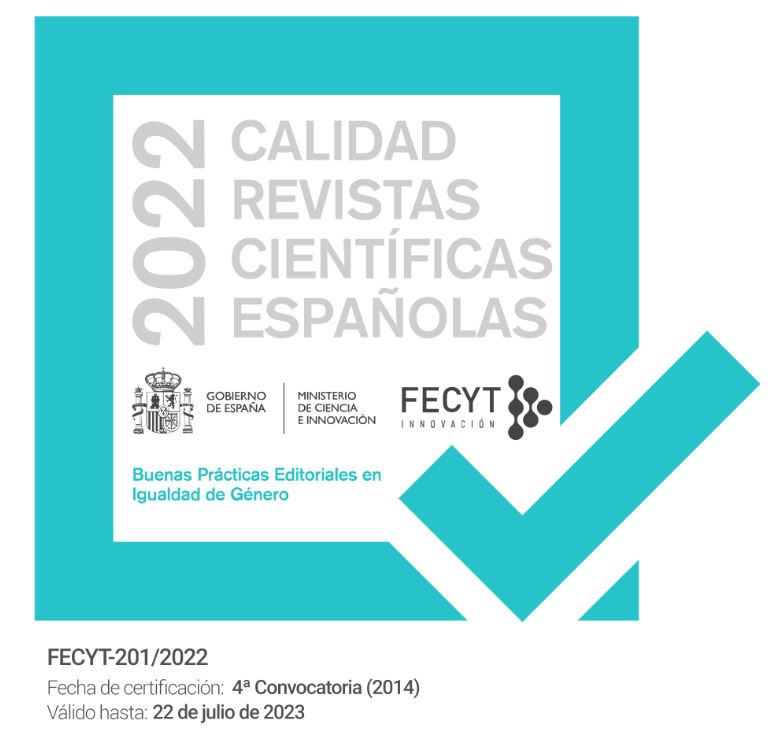Technophobia in ICTs: overcoming myths about the use of digital screens for learning
DOI:
https://doi.org/10.30827/eticanet.v24i1.29316Keywords:
digital screens, technophobia, information and communication technologies, ICT, vision, myopiaAbstract
As technology redefines education through Information and Communication Technologies (ICT), the increased use of digital screens raises concerns about their possible effects on visual health. By analyzing the scientific evidence, this paper debunks myths and clarifies misconceptions. It is not the observed object itself, but behavioral factors such as distance, illumination and pauses, as well as time spent outdoors, that are responsible for visual problems. Screens as educational tools present no greater risks than printed materials when used properly. In this constantly evolving technological landscape, it is crucial to foster digital literacy and balanced use of ICTs, empowering students and educators to take full advantage of the benefits that these modern tools can offer.
Downloads
References
Artal, P. Luz azul: ¿tan ogro como la pintan? (2014) (página web) https://www.jotdown.es/2014/10/luz-azul-tan-ogro-como-la-pintan/
Baird, P. N., Saw, S. M., Lanca, C., Guggenheim, J. A., Smith III, E. L., Zhou, X. y He, M. (2020). Myopia. Nature reviews Disease primers, 6(1), 99. https://doi.org/10.1038/s41572-020-00231-4
Brosnan, M. J. (2002). Technophobia: The psychological impact of information technology. Routledge.
Cai, X. B., Shen, S. R., Chen, D. F., Zhang, Q. y Jin, Z. B. (2019). An overview of myopia genetics. Experimental eye research, 188, 107778. https://doi.org/10.1016/j.exer.2019.107778
Chamorro, E., Bonnin‐Arias, C., Pérez‐Carrasco, M. J., de Luna, J. M., Vázquez, D. y Sánchez‐Ramos, C. (2013). Effects of light‐emitting diode radiations on human retinal pigment epithelial cells in vitro. Photochemistry and photobiology, 89(2), 468-473. https://doi.org/10.1111/j.1751-1097.2012.01237.x
Chu, C., Rosenfield, M., Portello, J. K., Benzoni, J. A. y Collier, J. D. (2011). A comparison of symptoms after viewing text on a computer screen and hardcopy. Ophthalmic and Physiological Optics, 31(1), 29-32. https://doi.org/10.1111/j.1475-1313.2010.00802.x
Cohen, Y., Iribarren, R., Ben-Eli, H., Massarwa, A., Shama-Bakri, N. y Chassid, O. (2022). Light intensity in nursery schools: a possible factor in refractive development. The Asia-Pacific Journal of Ophthalmology, 11(1), 66-71. DOI: https://doi.org/10.1097/APO.0000000000000474
Cortàzar, J. y Platón, F. (2014). El regalo de Teuth o el erudito ignorante. Reflexiones sobre escritura y formación a partir del Fedro, de Platón1.
Downie, L. E., Busija, L. y Keller, P. R. (2018). Blue‐light filtering intraocular lenses (IOLs) for protecting macular health. Cochrane Database of Systematic Reviews, (5). https://doi.org/10.1002/14651858.CD011977.pub2
Downie, L. E., Keller, P. R., Busija, L., Lawrenson, J. G. y Hull, C. C. (2019). Blue‐light filtering spectacle lenses for visual performance, sleep, and macular health in adults. The Cochrane Database of Systematic Reviews, 2019(1). https://doi.org/10.1002%2F14651858.CD013244
Dutheil, F., Oueslati, T., Delamarre, L., Castanon, J., Maurin, C., Chiambaretta, F. y Navel, V. (2023). Myopia and near work: a systematic review and meta-analysis. International Journal of Environmental Research and Public Health, 20(1), 875. https://doi.org/10.3390/ijerph20010875
Feldkaemper, M. y Schaeffel, F. (2013). An updated view on the role of dopamine in myopia. Experimental eye research, 114, 106-119. https://doi.org/10.1016/j.exer.2013.02.007
Gajjar, S. y Ostrin, L. A. (2022). A systematic review of near work and myopia: measurement, relationships, mechanisms and clinical corollaries. Acta Ophthalmologica, 100(4), 376-387. https://doi.org/10.1111/aos.15043
García-Montero, M., Felipe-Márquez, G., Arriola-Villalobos, P. y Garzón, N. (2022). Pseudomyopia: a review. Vision, 6(1), 17. https://doi.org/10.3390/vision6010017
Ham, W. T., Mueller, H. A., Ruffolo, J. J. y Clarke, A. M. (1979). Sensitivity of the retina to radiation damage as a function of wavelength. Photochemistry and photobiology, 29(4), 735-743. https://doi.org/10.1111/j.1751-1097.1979.tb07759.x
Hivert, A. F. (2023). https://www.lemonde.fr/planete/article/2023/05/21/numerique-a-l-ecole-la-suede-juge-les-ecrans-responsables-de-la-baisse-du-niveau-des-eleves-et-fait-marche-arriere_6174171_3244.html
Hua, W. J., Jin, J. X., Wu, X. Y., Yang, J. W., Jiang, X., Gao, G. P. y Tao, F. B. (2015). Elevated light levels in schools have a protective effect on myopia. Ophthalmic and Physiological Optics, 35(3), 252-262. https://doi.org/10.1111/opo.12207
Huang, H. M., Chang, D. S. T. y Wu, P. C. (2015). The association between near work activities and myopia in children—a systematic review and meta-analysis. PloS one, 10(10), e0140419. https://doi.org/10.1371/journal.pone.0140419
Huang, P. C., Hsiao, Y. C., Tsai, C. Y., Tsai, D. C., Chen, C. W., Hsu, C. C. y Liou, Y. M. (2020). Protective behaviours of near work and time outdoors in myopia prevalence and progression in myopic children: a 2-year prospective population study. British Journal of Ophthalmology, 104(7), 956-961. http://dx.doi.org/10.1136/bjophthalmol-2019-314101
Ip, J. M., Saw, S. M., Rose, K. A., Morgan, I. G., Kifley, A., Wang, J. J. y Mitchell, P. (2008). Role of near work in myopia: findings in a sample of Australian school children. Investigative ophthalmology & visual science, 49(7), 2903-2910. https://doi.org/10.1167/iovs.07-0804
Jones, L. A., Sinnott, L. T., Mutti, D. O., Mitchell, G. L., Moeschberger, M. L. y Zadnik, K. (2007). Parental history of myopia, sports and outdoor activities, and future myopia. Investigative ophthalmology & visual science, 48(8), 3524-3532. https://doi.org/10.1167/iovs.06-1118
Kinge, B., Midelfart, A., Jacobsen, G. y Rystad, J. (2000). The influence of near‐work on development of myopia among university students. A three‐year longitudinal study among engineering students in Norway. Acta Ophthalmologica Scandinavica, 78(1), 26-29. https://doi.org/10.1034/j.1600-0420.2000.078001026.x
Li, S. M., Li, H., Li, S. Y., Liu, L. R., Kang, M. T., Wang, Y. P. y Anyang Childhood Eye Study Group. (2015). Time outdoors and myopia progression over 2 years in Chinese children: the Anyang Childhood Eye Study. Investigative ophthalmology & visual science, 56(8), 4734-4740. https://doi.org/10.1167/iovs.14-15474
Madigan, S., McArthur, B. A., Anhorn, C., Eirich, R. y Christakis, D. A. (2020). Associations between screen use and child language skills: a systematic review and meta-analysis. JAMA pediatrics, 174(7), 665-675. https://doi.org/10.1001/jamapediatrics.2020.0327
Pan, C. W., Qian, D. J. y Saw, S. M. (2017). Time outdoors, blood vitamin D status and myopia: a review. Photochemical & Photobiological Sciences, 16, 426-432. https://doi.org/10.1039/c6pp00292g
Park, D. J. J. y Congdon, N. G. (2004). Evidence for an" epidemic" of myopia. ANNALS-ACADEMY OF MEDICINE SINGAPORE, 33(1), 21-26.
Pärssinen, O. (2012). The increased prevalence of myopia in Finland. Acta ophthalmologica, 90(6), 497-502. https://doi.org/10.1111/j.1755-3768.2011.02210.x
Patel, S., Henderson, R., Bradley, L., Galloway, B., & Hunter, L. (1991). Effect of visual display unit use on blink rate and tear stability. Optom Vis Sci, 68(11), 888-892
Rose, K. A., Morgan, I. G., Ip, J., Kifley, A., Huynh, S., Smith, W. y Mitchell, P. (2008). Outdoor activity reduces the prevalence of myopia in children. Ophthalmology, 115(8), 1279-1285. https://doi.org/10.1016/j.ophtha.2007.12.019
Rosen, L. D. y Weil, M. M. (1995). Computer availability, computer experience and technophobia among public school teachers. Computers in human behavior, 11(1), 9-31. https://doi.org/10.1016/0747-5632(94)00018-D
Rosenfield, M. (2011). Computer vision syndrome: a review of ocular causes and potential treatments. Ophthalmic and Physiological Optics, 31(5), 502-515. https://doi.org/10.1111/j.1475-1313.2011.00834.x
Sterner, B., Gellerstedt, M. y Sjöström, A. (2004). The amplitude of accommodation in 6–10‐year‐old children–not as good as expected!. Ophthalmic and Physiological Optics, 24(3), 246-251. https://doi.org/10.1111/j.1475-1313.2004.00201.x
Wright, P. y Lickorish, A. (1983). Proof-reading texts on screen and paper. Behaviour & Information Technology, 2(3), 227-235. https://doi.org/10.1080/01449298308914479
Wu, P. C., Tsai, C. L., Hu, C. H., & Yang, Y. H. (2010). Effects of outdoor activities on myopia among rural school children in Taiwan. Ophthalmic epidemiology, 17(5), 338-342. https://doi.org/10.3109/09286586.2010.508347
Wu, P. C., Tsai, C. L., Wu, H. L., Yang, Y. H. y Kuo, H. K. (2013). Outdoor activity during class recess reduces myopia onset and progression in school children. Ophthalmology, 120(5), 1080-1085. https://doi.org/10.1016/j.ophtha.2012.11.009
Wu, L. J., Wang, Y. X., You, Q. S., Duan, J. L., Luo, Y. X., Liu, L. J. y Wang, W. (2015). Risk factors of myopic shift among primary school children in Beijing, China: a prospective study. International journal of medical sciences, 12(8), 633. https://doi.org/10.7150/ijms.12133
Xiong, S., Sankaridurg, P., Naduvilath, T., Zang, J., Zou, H., Zhu, J. y Xu, X. (2017). Time spent in outdoor activities in relation to myopia prevention and control: a meta‐analysis and systematic review. Acta ophthalmologica, 95(6), 551-566. https://doi.org/10.1111/aos.13403
Young, F. A., Leary, G. A., Baldwin, W. R., West, D. C., Box, R. A., Harris, E. y Johnson, C. (1969). The transmission of refractive errors within Eskimo families. Optometry and Vision Science, 46(9), 676-685.
Zylbermann, R., Landau, D., y Berson, D. (1993). The influence of study habits on myopia in Jewish teenagers. Journal of Pediatric Ophthalmology & Strabismus, 30(5), 319-322. https://doi.org/10.3928/0191-3913-19930901-12
Downloads
Published
Issue
Section
License
The authors who publish in this journal agree to the following terms: The authors retain the copyright and grant the journal the right to be the first publication of the work as well as licensed under a Creative Commons Attribution License that allows others to share the work with an acknowledgment of the authorship of the work and the initial publication in this magazine. Authors are allowed and encouraged to disseminate their work electronically (for example, in institutional repositories or on their own website) before and during the submission process, as it may lead to productive exchanges as well as further citation. Earliest and greatest of published works (See The Effect of Open Access).













